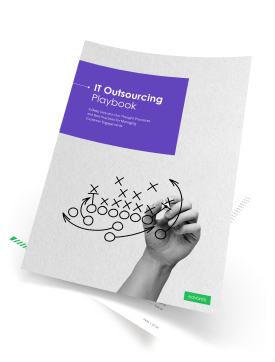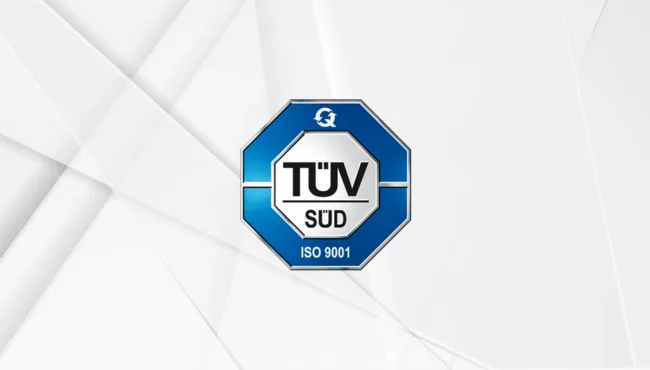
With pressing tech talent shortages, leaders seek alternative candidate sourcing strategies. Outsourcing to IT vendors, understandably, appears among the top choices. According to a 2021 Deloitte survey, experienced buyers already have an average of 65% of total full-time hires within the IT function supplied by outsourcing vendors and shared services providers. That’s a seven percentage point increase compared to 2019.
Such partnerships aren’t just about filling talent gaps, though. Survey respondents also highlight other strategic benefits obtained from outsourcing IT services.
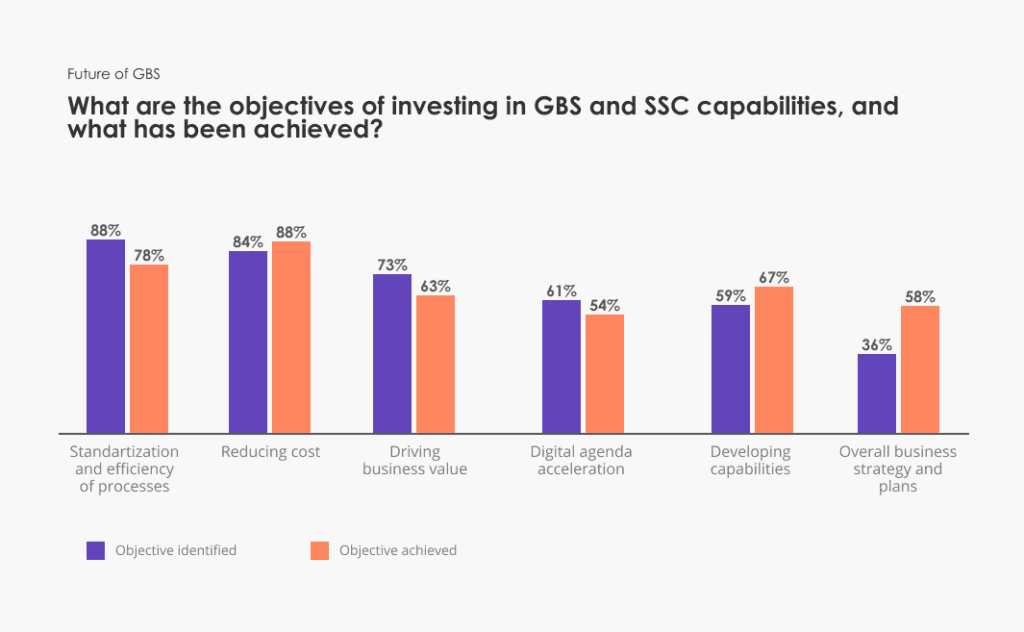
Source: Deloitte
So, if your company also considers moving forward with IT outsourcing, this guide explains how to select the right partner.
IT Outsourcing Vendor Selection: General Premises of Good Partnerships
Every purchase decision has an evaluation stage: You have options and want to determine which one’s best for you.
When you are shopping for software, the choice is relatively easy. You get presented with a list of features, use cases, and possible integrations, paired with a selection of subscription plans or licenses.
Purchasing IT services, in most cases, is more complicated. They are more variable and come at different price points. Rather than comparing features and benefits, you’re stacking up the IT vendor’s expertise, maturity levels, pricing, and available staffing resources. To get objective results, you need to have a system for doing the comparison.
IT vendor assessment is a systemized process of evaluating a technology services provider based on a set list of criteria. The assessment looks at specific business objectives, your operating model, risk tolerance profile, and budgetary considerations.
It’s a framework you apply to determine if an IT outsourcing company can meet your quality standards and proposed obligations under a contract. The vendor, too, analyzes your company to determine the adequacy of proposed collaboration terms.
IT outsourcing vendor assessment is tedious because you’ll often encounter unstandardized service models and too-good-to-be-true pitches rather than turnkey, scoped packages. During the subsequent negotiations, your goal is to determine whether the vendor can:
- Supply the expertise you require
- Meet the quality standards set for the project
- Adapt to your operating model for effective collaboration
The vendor, in turn, assesses your operational readiness for outsourcing, maturity of project vision, and ability to effectively contribute to this partnership. The aim is to manage internal stakeholder expectations, provide timely information, and ensure effective team management. If you find common ground and align on the vision, the two of you move to the next stages of the engagement process — preliminary proposal and IT services contract development.
As it’s easy to imagine, IT outsourcing vendor assessments can drag on when your process lacks structure and objective evaluation criteria. This post aims to provide you with several pointers for creating a repeatable IT outsourcing vendor assessment process.
6-Step IT Outsourcing Vendor Selection Framework
Whether you are on the market for a new apartment or a new CRM app, there are two factors to limit you: your needs (list of requirements) and your budget (the sum you can afford to spend).
When selecting IT outsourcing services, these two factors stay the same. If you are facing budget constraints, you’ll have to compromise on some nice-to-haves. If you are bent on getting everything from your list, prepare to bear the respective costs.
We’ve created six tips for new buyers to arrive at this golden middle. You can treat our framework as an alternative or prep step to the request for proposal (RFP) process — a more complex assessment some businesses choose to make.
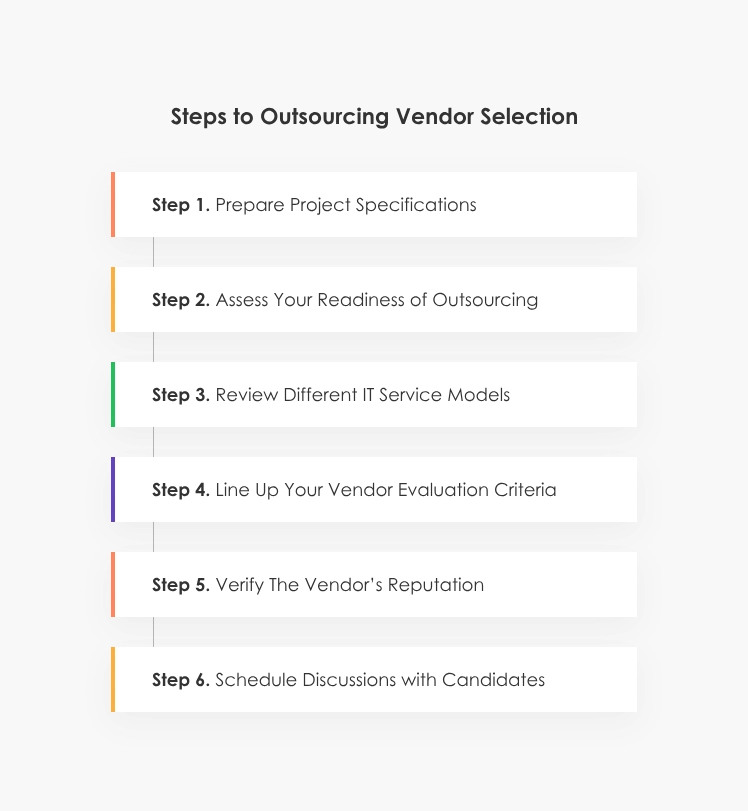
1. Prepare Project Specifications
To receive a “yes, we can do this” or “no, this isn’t up to our alley” response from an IT vendor, you have to debrief them on your project.
In other words: Provide them with sufficient information to make an objective call on whether your project matches their experience, minimum project engagement fees, and current priorities.
Your early communication with an evaluated IT outsourcing vendor has to include the following:
- General project overview — your vision, goals, and objectives. Summarize what you are trying to create or what operational issues you’d like to solve with a short “why” behind it.
- Expected scope of work and project requirements. At the assessment stage, you can document the scope of work as a list of jobs to be done, later formalized into a list of technical requirements.
Pro tip: If you struggle to articulate all your project requirements, seek an IT outsourcing vendor that offers Discovery sessions.
A discovery phase in software development is a set of meetings where your vendor’s team helps you frame the main problem statement(s), identify critical functional and non-functional software requirements, map possible constraints, and suggest the optimal team composition and tech stack you’ll need.
Discovery helps new outsourcing buyers, especially those without an in-house business analysis unit, to support the effort internally.
NB: If an outsourcing vendor encourages you to move ahead with collaboration without seeing a detailed list of requirements first (as well as information on any constraints, risks, or blockers at your end), be wary of such offers. In the best-case scenario, you’ll end up with a higher-than-anticipated bill. In the worst case, you’ll have a vastly side-tracked engagement.
2. Assess Your Readiness of Outsourcing
As part of your preparation, you should also get a good look at your operations. Is your company ready to effectively onboard and supervise the external workforce?
When your operating model isn’t conducive to IT outsourcing (which is mostly the case for first-time buyers), you’ll have to do some groundwork first. To determine your outsourcing readiness levels, consider the following questions:
- How will an outsourcing vendor fit into your overall strategy?
- Can you scale your current operating processes beyond the corporate borders (to accommodate remote team members)?
- Do you have appropriate governance for overseeing the outsourced project and vendor-supplied team?
- How can you adapt your collaboration and communication processes to accommodate an external party?
- Which roles or skill sets do you need and at what capacity — full-time, part-time, need-based?
- Do you have an established process for forming and clarifying project requirements and then disseminating the information to the distributed development team?
Check our IT outsourcing readiness assessment checklist to better identify where you currently stand.
3. Review Different IT Service Models
There’s no industry-wide standardization of IT service models in outsourcing because of the varying nature of work.
Many smaller vendors prefer the “classic,” price-tied service models such as:
- Times and material (T&M) – open-ended contracts, where you pay for a total number of hours reported by the team.
- Fixed-price projects – you get a price upfront for a set number of deliverables.
The issue is that neither works well for long-term technology partnerships, where you and the IT vendor collaborate on a complex product throughout the software development life cycle (SDLC) stages.
That’s why at Edvantis, we chose to go with alternative IT outsourcing service models, which better reflect the partnership scope and obtained value:
- Staff Augmentation: An IT outsourcing vendor augments your in-house teams with the specialist you need in an expressed capacity. You treat the new members as part of your staff — and manage them directly.
- Dedicated Team: Rather than individual IT talent, you partner up with a cross-functional team assembled specifically for your project — and co-managed by you and the vendor jointly.
- Fixed-price Project: An end-to-end, scoped project delivery fully done by the vendor. In most cases, managed projects are mostly MVPs or proof-of-concept software solutions based on a pre-agreed list of requirements.
Read more about IT service models in outsourcing.
4. Line Up Your Vendor Evaluation Criteria
You’re ready to go into the field and schedule conversions with prospective IT outsourcing vendors. To make a shortlist of viable candidates, group all options by the following general criteria first:
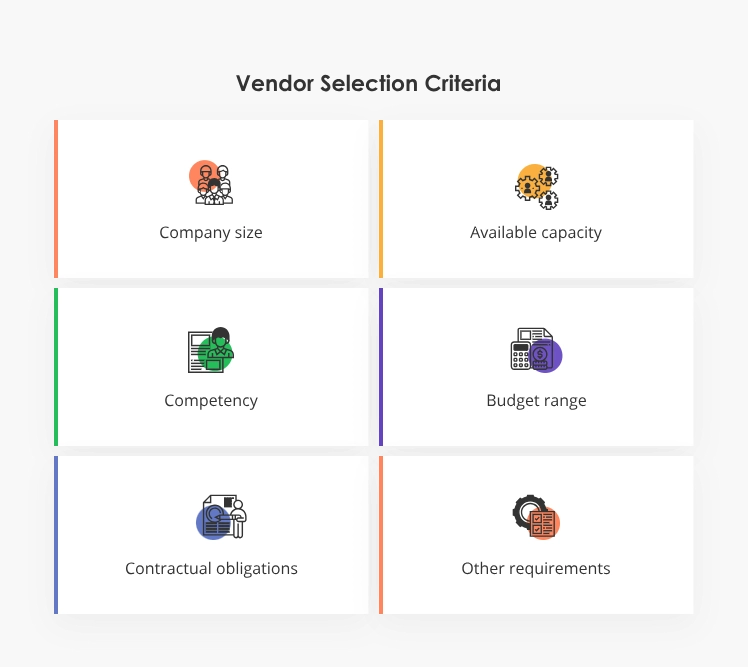
- Company size. Smaller boutique agencies might be unable to handle larger projects or supply complementary services (e.g., data science). Transnational firms, in turn, won’t be as short-staffed but might be slower to move and more selective with the accounts they choose to carry.
- Available capacity. Can the potential vendor supply as many resources as you need? Is there room for up-scaling?
- Competency. Does the vendor have experience with the tech stack you intend to use? Do they specialize in your industry? Request case studies or customer references to determine.
- Budget range. Does the vendor have any minimal project engagement rate? Do their suggested rates fall into the price spectrum your company can afford?
During the subsequent discussions, evaluate the vendor based on the following:
- Proposed contractual obligations include service scope, obligations of each party, SLA terms (if applicable), remedies for failure to meet the set commitments, etc.
- Other special requirements your business has around data security, data storage, IP rights, etc.
Use the above criteria to create a vendor scoreboard. Then, rank each candidate against the set list of criteria. To make the assessment accurate, prioritize evaluation criteria by adding different priorities. Assign higher values to areas you deem the most important for your business to select the optimal vendor for your company rather than the best overall fit.
5. Verify The Vendor’s Reputation
You want a business partner you can trust. In the digital age, reputation is easy to research and corroborate. Start with high-level research on the company’s public presence. Check general feedback on industry review websites like Clutch and review case studies published by the vendor.
Many companies also provide supplementary information on corporate values, operating principles, and codes of conduct. Look for vendors who work in the open and proactively share information on their standards, processes, and expertise.
When assessing a shortlist of IT vendors, a good practice is to ask for private references and referrals to past clients. If the vendor is willing to connect you with another client, that’s a good sign.
6. Schedule In-Depth Discussions with the Shortlisted Candidates
Once you have your front-runner, schedule the final introductory call to discuss the planned collaboration scope.
During this meeting, pay attention to:
- Communication vector: Does the vendor try to understand the gist of your project? Are they asking technical questions (not just budget and cooperation-related ones?
- Suggested service models: Does the vendor offer various service models or attempt to shoehorn you into one option? Do they explain the differences between service models? Is there an option to start small and then scale up?
- Risk suggestions: Does the vendor acknowledge the project risks and offer any mitigation paths? Do they suggest internal improvements before the partnership kick-off?
Remember: Mature IT outsourcing vendors try to understand your business, promote knowledge sharing, and recommend ways to ensure high project success rates. Respectively, many would avoid moving forward with clients who aren’t willing to make any adjustments on their end. After all, if the partnership falls through, it’s their reputation on the line too.
Read more about the principles of successful IT outsourcing partnerships.
Conclusions
IT outsourcing vendor selection can become time-consuming without proper structure. Make your list of fair evaluation criteria and stack each contender against them. Go with the company offering transparent, scoped, well-structured approaches to IT service delivery.
Vendors with a mature engagement process for new clients are more likely to excel in subsequent operational alignment, SDLC management, and ongoing strategic partnerships.
If you are new to IT outsourcing vendor selection, contact Edvantis to book a free workshop with our team, where we answer your questions and help you get operationally ready for outsourcing.

